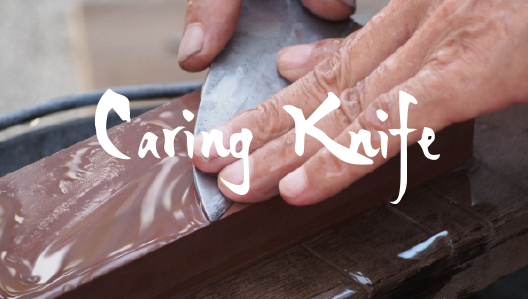Already got the best Japanese knife of your dream? You won’t just use it right? Knowing how to take care properly of that special knife you have will save you from disappointment, headache due to repair and avoid your money from going to waste. So possessing one is also a duty of yours to know from proper usage, caring up to it’s storage. Lacking knowledge may lead to losing your most precious knife. It may start rusting, chipping, losing the promising sharpness and worst may lead to an injury that should not happen to anyone. It’s just as easy as one,two and three.
1.How do you use your Japanese knife
The usage of Japanese knives is different from the ordinary knife you may find inside your kitchen.
They are special, characterised for having a single bevel. The single bevel angle is formed on one side only, meaning the one side has an incline that runs down to the edge of a knife and the smaller the angle will give the sharpest blade you got. Japanese knives also have thinner, harder, sharper bevels made of high quality steels, and lighter for hand balance.
These are the reasons they are so expensive but many professional chefs are into them. But digging deep will make you know that due to their characters they also have cons and to avoid those you must know it first.
- They are more prone to chipping since the blade is thinner.
- Rust easily so wash it every use.
- These knives are more expensive since they are lightweight.
Every type of Japanese knife has their differences too, they are made to do different tasks in the kitchen. Every one of them is specially made for that one assignment so it’s better for you to know very well. So that chipping may be avoided in the future.
Here’s a list of some type of knife and their usage.
| Deba Bocho | kitchen cleaver knife |
| Fugu Hiki | used to cut very thin slices of the blowfish called fugu |
| Hancho Hocho | used to fillet tuna |
| Honyaki | forged knives |
| Nakiri Bocho | used to cut vegetables |
| Oroshi Hocho | for filleting tuna |
| Santoku | all-around knife in the kitchen |
| Soba Kiri | used to make soba |
| Tako Hiki | used as sashimi slicer |
| Udon Kiri | used to make udon |
| Unagisaki Hocho | used to butcher and fillet eel |
| Usuba Bocho | used by professional chefs |
| Yanagi Ba | used for slicing sashimi |
| Ai-Deba | combined deba bocho and mioroshi deba, used to carve meat |
| Ajikiri | used for small fish, vegetable, and meat |
| Bunka Bocho | another name for santoku |
| Chuka Bocho | cleaver that is similar to Chinese cleaver |
| Dakketsu | used for bleeding fish to keep fresh |
| Gyuto | similar to Western chef’s knife but with thinner blade |
| Garasuki | used for boning poultry |
| Hankotsu | used to separate bones from meat |
| Ikasaki | used for squids |
| Kaimuki | used for shucking shellfish, oysters, and scallops |
| Kawamuki | known as garnishing knife |
| Kujira Hocho | used to cut whales, shark, tuna, and swordfish |
| Kurinuki | used peel, carve, and cut fruits and vegetables into fancy shapes |
| Reitou Hocho | used for cutting frozen meat |
| Suikakiri | used for cutting watermelon |
| Sujihiki | used for slicing both raw and cooked meats, and fat |
Other reasons that we are guilty about and must be avoided to be done with our knives.
- Choosing a chopping board to use. It is recommended to use wooden or plastic boards. Using this will keep the blade sharp for a long time.
- Frozen meats, chopping a meat right from your freezers may harm the knife doing so may cause chipping. Aside from frozen, choosing the right knife to chop meat with bones may also be a cause. It’s like using a dull knife that will force you to use more power to chop.
- Scrapping across the cutting board. Clearing away after you chop to have a space by directly using the knife blade is a sin with your knives. Well, we’re guilty. It ruins the blade so to avoid it just use the back or dull side of the knife next time or use your hands and just pick it up.
- Using the knife for unnecessary tasks like opening a can, opening a box, your knife is not a cutter, and well we use them sometimes as a screwdriver etc. These kinds of activities may lead to loss of tip, ruin the blade and lose its sharpness.
2.Washing and Storage of your Japanese Knife after use
After using a knife for a tiring time of chopping they also should be pampered right the proper way they must be. Washing them right away after every use is the best thing to do to avoid rusting. But simply washing was not enough.
Here’s a list of activities we must stop doing with our knife after use.
- Leaving it in the sink,
- Using a Dishwasher to wash the knife.
- Leaving to air dry at the drying rack
- Clattered in a drawer
Instead do this with your knives.
- Wash it by hand every after use
- Use a mild soap
- Dried with a towel (Putting some oil was also done by some people after drying)
- Look for a safe storage away from children
- Use sheath before storing
- Aside from sheath we recommend the use of magnetic knife rack or Dock in-drawer knife storage
3.How to take care of Yanagiba Knife
Yanagiba knife is a knife used for filleting fish that was served in sushi restaurants. It’s acute edge angle along with a narrow blade allows it to cut easier and smooth without the effort of cutting pressure with minimal stroke. Since it is a single bevel knife only one side of it is needed to be sharpened.
Steps on how to sharpen a Yanagiba knife.
- Burr- is a part of Yanagiba sharpening process. Remember that to begin you should first set up a burr on the knife before using a finer grit sharpening stone. This helps you to know if you have finished creating a fine edge on the side of the bevel.
- Prepare a Whetstone
- Sharpen the knife by drawing the edge backward and forward at an angle of 10-15 degrees. After that do the Uraoshi sharpening this will remove the burr and don’t use too much pressure and strength while doing so.
- Polishing- here you’ll just have to use a finer grit whetstone. By just repeating the procedure before. Do this by aligning the blade to the whetstone in a 90 degree position.
- Also use of towel or cloth will help you to prevent the whetstone from slipping while sharpening.
4.Naniwa Whetstone
Naniwa Abrasive MFG. Co.,LTD. Is a japanese manufacturing of sharpening stones, diamond tools, sandblasting system and abrasion.
Established in 1941 and located in Osaka Japan. They offer different sharpening stones that will match your Japanese knives such as Professional stone series, Super stone series with a combination stone that is a better choice for sharpening and finishing, Traditional stone series, and Multi stone series. Accessories are available too such as Stone holder, flattening stone, accessory stone, guide clip for sharpening, dressing stone, and rust eraser. Chosera and Super stone are only available on the Japan market only.
There is also a guide for you on the website on How to sharpen. For more information and for product browsing you may visit their online store please click on the link below.
Market in EU, USA, Canada and Australia
5.Naniwa Whetstone Review
Here are some reviews of Kaniwa Whetstone.
Got some of NOS whetstone from visiting Kyoto a few weeks ago. This one is Naniwa Kagaku Toishi, they produced before they start to produce Chosera/ Naniwa Professional regularly, so pretty similar feeling as Chosera/ Naniwa Professional. pic.twitter.com/T36jH4KAIK
— HITOHIRA (@hitohirajapan) November 8, 2019
A whetstone that isn’t mentioned much is the Naniwa Professional 600, the blue stone. I use it every day and it’s often after a 220 or 320. The stone hardly dishes at all, nice feedback too, it’s excellent. I got mine at @paulsfinest, strongly recommended. pic.twitter.com/Dj4D2ac5ce
— Peter Nowlan (@SharpknivesNS) November 30, 2020
Great rig.
— Walter Harding (@WalterH52219486) April 7, 2020
My go to is my naniwa 3000 from Japan.
Great whetstone.
Soak and go , 11 degrees.
Once a month with her and then use the leather paddle align and my knives are ready to go.
It’s fun to take a full knife and sharpen them.
I do it for all my friends. pic.twitter.com/ZVF5Sti4nQ
6.Summary
This article is written to help those persons who are possessing a Japanese knives and even those who are planning to have one in the future.
Hope this will be a reference of yours to know that maintaining your Japanese knives is easy, you just have to know how. Here we write down the proper usage of each knife and some wrong practices that we do with our knife so that we can avoid doing so next time. Proper washing and storage was discussed too since it is also a big impact to keep the knife performance and to prolong its life.
We introduce the Naniwa Whetstone product made from Japan, a perfect match for your Japanese brand knife. You may visit their official online store at https://www.naniwa-kenma.co.jp/. They are offering different kinds of sharpening tools that will surely meet your expectations.


